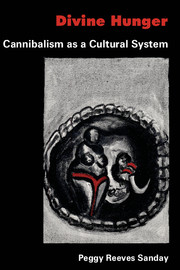Book contents
- Frontmatter
- Contents
- Preface
- Acknowledgments
- Introduction
- The symbols that give rise to a cannibalistic consciousness
- 3 The mysteries of the body: Hua and Gimi mortuary cannibalism
- 4 The androgynous first being: Bimin-Kuskusmin cannibalism
- 5 Cannibal monsters and animal friends
- The mythical chartering and transformation of cannibal practice
- Notes
- References
- Index
5 - Cannibal monsters and animal friends
Published online by Cambridge University Press: 05 June 2012
- Frontmatter
- Contents
- Preface
- Acknowledgments
- Introduction
- The symbols that give rise to a cannibalistic consciousness
- 3 The mysteries of the body: Hua and Gimi mortuary cannibalism
- 4 The androgynous first being: Bimin-Kuskusmin cannibalism
- 5 Cannibal monsters and animal friends
- The mythical chartering and transformation of cannibal practice
- Notes
- References
- Index
Summary
It is very natural that in a country which really produces isolated instances of such horrors [cannibalism], and with a nation so devoted to fancies and dreams, superstition should be mixed up in the matter, and that at last, through this superstition, wonderful stories of windigos should be produced, as among us, in the middle ages, the belief in witches produces witches. … in the same way fear has caused some gloomy-minded people to be regarded as windigos; and, worst of all, this fear and the general opinion have so worked upon some minds, that they believe themselves to be really windigos, and must act in that way. … It is just like the “Sorrows of Werther.” First, there is a Werther in real life, whom the poets render celebrated, and at last the nation is innoculated with Werthers.
In this chapter I discuss the meaning of three cultural images of the cannibal monster: the Windigo of the Algonkian Indians of northeastern North America; the Wechuge of boreal forest Athapaskans (North America); and the Man Eater of the Kwakiutl Indians of the Northwest Coast of North America. Fear of the cannibal monster in the form of animal-man beings or the tamam witch was encountered in Chapter 4. This fear, dressed in various cultural clothes, is probably a cultural universal, appearing in all societies in response to concerns about the antisocial power of hunger.
- Type
- Chapter
- Information
- Divine HungerCannibalism as a Cultural System, pp. 102 - 122Publisher: Cambridge University PressPrint publication year: 1986



